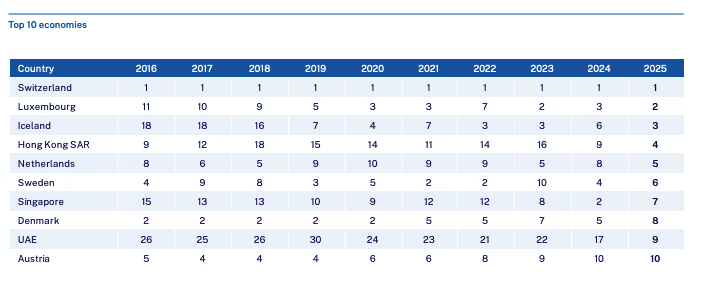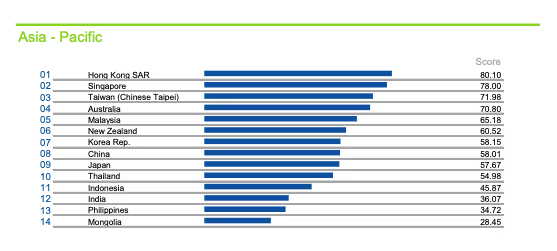BLOG |
Business Insights
Published:
19 Sep 2025
Last updated:
19 Sep 2025


The latest IMD World Talent Ranking reveals a dynamic APAC talent ecosystem – here's what HR leaders need to know to navigate expansion with confidence
The release of the IMD World Talent Ranking 2025 offers compelling insights into the evolving talent landscape across Asia-Pacific, with implications that extend far beyond rankings. For HR leaders contemplating or actively pursuing APAC expansion, this data represents more than competitive positioning – it's a strategic roadmap for sustainable growth in the world's most dynamic economic region.
The 2025 rankings reveal APAC's continued ascendancy in global talent competitiveness, with Hong Kong (4th) and Singapore (7th) securing coveted top-10 positions globally. However, the story extends beyond these established hubs. Taiwan (17th), Australia (19th), and Malaysia (25th) have earned their place in the top 30, demonstrating the region's depth of talent opportunities.
What this means for HR leaders: The traditional "Singapore-Hong Kong duopoly" is evolving into a multi-hub ecosystem. This diversification creates both opportunities for cost optimization and challenges in maintaining consistent talent quality across markets.

Hong Kong's remarkable five-position jump from 9th to 4th place reflects significant improvements across all talent competitiveness factors. The city's strengths paint a picture of a market primed for knowledge-intensive industries:
Strategic implication: Hong Kong has repositioned itself as a STEM talent hub, making it particularly attractive for fintech, biotech, and deep tech expansions. However, the cost-of-living challenge (66th globally) and negative labor force growth (-0.39%) suggest that talent acquisition strategies must be both competitive and retention-focused.
Singapore's drop from 2nd to 7th position, despite two successive years of improvement, reflects the dynamic nature of talent competitiveness. The city-state maintains formidable strengths:
Critical insight: Singapore's challenges mirror those of many mature APAC markets – cost-of-living pressures (65th globally) and relatively low public expenditure on education (63rd globally) create sustainability questions for long-term talent strategies.

The rankings reveal a compelling "middle tier" of APAC markets that smart HR leaders should consider for their expansion strategies:
With a score of 71.98% and particularly strong readiness indicators (11th globally), Taiwan represents exceptional value for tech-focused organizations. The market combines developed-economy talent quality with emerging-market accessibility.
Malaysia ranked first globally among economies with GDP per capita less than $20,000, positioning it as the premium choice for cost-conscious expansions without compromising talent quality.
The IMD data reveals critical patterns that should inform every APAC talent strategy:
The most competitive countries achieve a recognizable balance across all three pillars of investment and development, appeal, and readiness, avoiding overreliance on a single strength. This suggests that HR leaders should evaluate markets holistically rather than focusing solely on cost or single talent metrics.
Economies like Kazakhstan, Latvia, and Estonia demonstrate that strategic use of limited education budgets can outperform more generously funded but less effective systems. For HR leaders, this reinforces the importance of talent ROI over pure salary arbitrage.
International student mobility is the foundation of future talent strategies, with countries like Canada and Germany successfully integrating foreign students into their labor markets. APAC markets demonstrating similar capabilities should be prioritized for long-term talent pipeline development.
The 2025 rankings emerge against a backdrop where financial security and tangible benefits are the most frequently cited drivers for international relocation, contrasting with the pre-COVID-19 pandemic era when quality of life, cultural fit, and language ranked higher.
This shift demands a fundamental recalibration of APAC talent strategies:
From lifestyle to livelihood: Traditional expat packages emphasizing cultural amenities must evolve toward comprehensive financial security frameworks.
From uniformity to localization: Financial incentives are highest for executives in countries experiencing economic uncertainty or rapid change, and lowest in environments considered financially secure or predictable, suggesting market-specific compensation strategies are essential.
The IMD analysis identifies three overarching challenges that will define APAC talent competitiveness:
Bridging gender gaps in labor force participation remains critical. Organizations that proactively address this through inclusive policies and flexible work arrangements will access larger talent pools and demonstrate market leadership.
Aligning educational outcomes with rapidly evolving workforce demands requires continuous upskilling strategies. HR leaders must build learning ecosystems that transcend traditional training models.
Offering a compelling value proposition that combines quality of life with affordability demands creative approaches to total rewards packages, particularly in high-cost markets like Hong Kong and Singapore.
Based on the IMD insights, here's your actionable framework for APAC talent success:
Move beyond the Singapore-Hong Kong axis. Consider Taiwan for technology roles, Malaysia for operational excellence, and Australia for regional leadership positions. This diversification mitigates risk while optimizing costs.
Tailor your employee value proposition to local talent priorities. In high-cost markets, emphasize career acceleration and global exposure. In emerging markets, focus on professional development and international experience.
Engage with universities and technical institutions in markets showing strong international student mobility. Building relationships with emerging talent ensures sustainable recruitment as markets mature.
Create internal mobility frameworks that allow talent to move between APAC markets. This approach maximizes your investment in employee development while addressing local market constraints.
While the IMD ranking provides valuable market intelligence, successful APAC expansion requires navigating complex regulatory landscapes that vary dramatically across markets. Employment laws, tax regulations, and compliance requirements can transform a promising talent strategy into a costly liability without proper guidance.
This is where the value of no uncertainty, no penalty, no hidden costs becomes paramount. Organizations attempting to navigate APAC's diverse regulatory environment without local expertise often encounter:
The IMD World Talent Ranking 2025 confirms what forward-thinking organizations already recognize: APAC represents the world's most dynamic talent ecosystem. The region combines deep talent pools, competitive costs, and improving infrastructure to create unprecedented opportunities for growth.
However, success requires more than market selection – it demands strategic execution with local expertise. Those that can innovate while preserving strong policy foundations will be best positioned to lead the next era of global talent competitiveness.
The question isn't whether to expand into APAC, but how to do so with the confidence and peace of mind that comes from expert guidance and comprehensive support.
As talent competitiveness continues to evolve, one truth remains constant: the organizations that act decisively, with proper support and strategic thinking, will capture the greatest share of APAC's talent dividend.
The IMD World Talent Ranking 2025 assessed 69 economies across three dimensions – investment and development, appeal, and readiness – using 31 criteria to evaluate countries' capacity to develop, attract, and retain human capital.